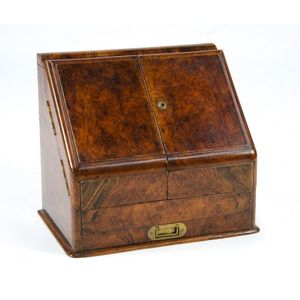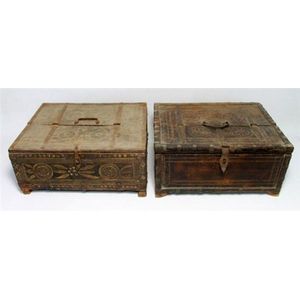Ethel's Trunk: A 19th Century Ship's Treasure
You must be a subscriber, and be logged in to view price and dealer details.
Subscribe Now to view actual auction price for this item
When you subscribe, you have the option of setting the currency in which to display prices to $Au, $US, $NZ or Stg.
- Huon Pine - Named after the Frenchman who discovered the Huon River in Tasmania, it is an extremely slow growing and long living tree. Huon pine is native to Tasmania, and it can grow to an age of 3,000 years or more. The wood contains oil that retards the growth of fungi, hence its early popularity in ship-building in convict-era Tasmania. The timber is a warm yellow colour, finely grained, and was popular for household furniture in the Victorian era. Interestingly, much Huon pine furniture was made in South Australia. Huon pine is a protected species and only limited quantities are available nowadays, for craftsmen to manufacture small items such as platters, sculptures and other decorative objects.
- Blackwood - One of the best known and most widely used Australian timbers, blackwood (acacia melanoxylon), is a member of the Acacia (wattle) family and grows in eastern Australia from about Adelaide in South Australia, as far north as Cairns in Queensland.
The largest, straightest and tallest trees come from the wet forest and swamps of north-west Tasmania where it is grown commercially.
Blackwood timber colours range across a wide spectrum, from a very pale honey colour through to a dark chocolate with streaks of red tinge.
The hardwood timber has been commonly used in the production of furniture, flooring, and musical instruments in Australia from the late 19th century. However, the straight grain timber is not the most prized or valuable, that honour falls to blackwood with a wavy, fiddleback pattern, which is used both in the solid and as a veneer. Fiddleback was only used on the finest examples of furniture. - Dovetail Joints - At regular intervals in one board, wedge-shaped projections are cut, which fit and are glued into matching recesses cut in the corresponding board opposite, thus forming a 'dovetail' appearance. One of the strongest joints devised for furniture. Found in most drawers and the joints fixing the tops, bottoms and rails at right angles to the side pieces of most cabinets. Before the invention of the dovetail joint, furniture had been held together by metal or wooden dowels or pegs.
This item has been included into following indexes:
Visually similar items

A Victorian brass bound walnut writing box, 40 cm wide, 25 cm deep, 18 cm high

Desk compendium: antique burr walnut slope front box with 2 doors revealing compartments, ink pots and calendar top. Original key and patina. Good condition

Two rectangular Indian Dowry Chests, with original metal fittings, 19th/20th century, carved & painted, 18 x 33 x 43 cm each

An Australian Arts & Crafts carved oak box, the hinged top carved with gumnuts and leaves, the front carved with two owls on a branch with gumnuts and the carrying handles on either side carved with gumnuts and leaves, raised on later bun feet, with plain
